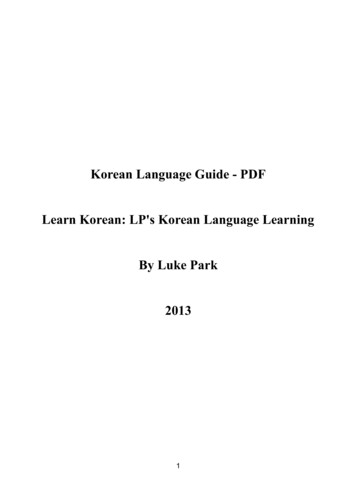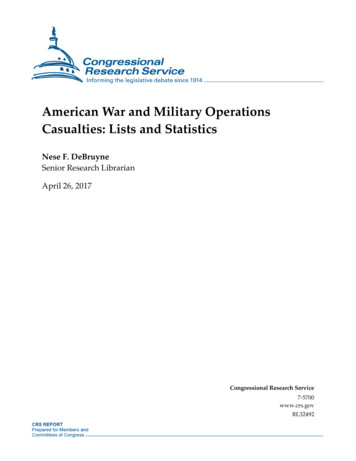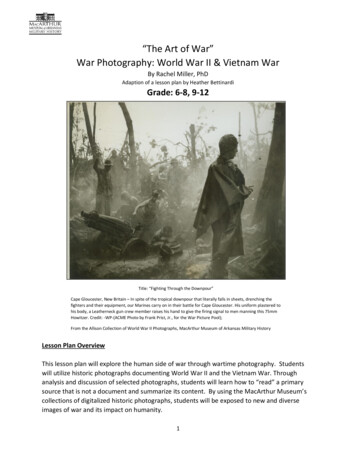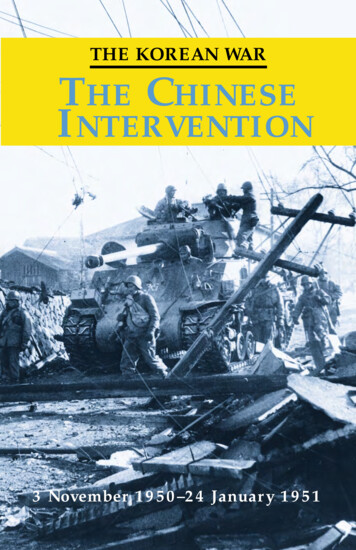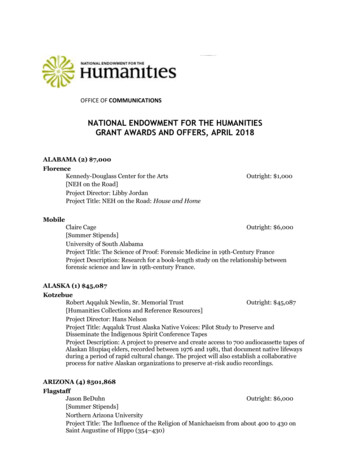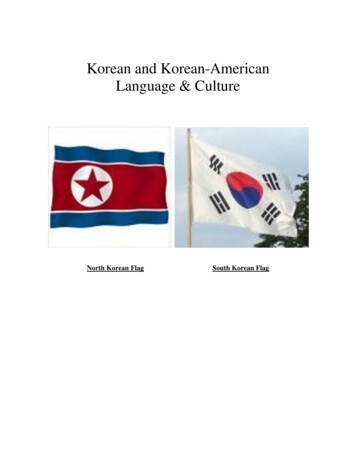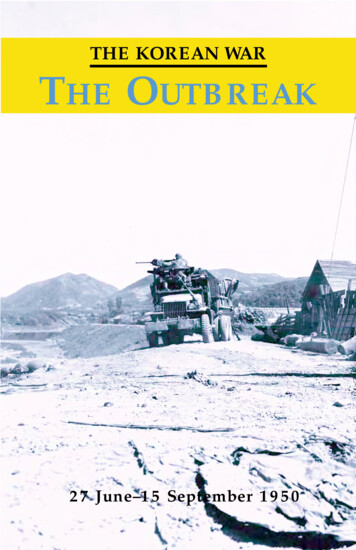
Transcription
THE KOREAN WARTHE OUTBREAK27 June–15 September 1950
IntroductionThe Korean War was the first major armed clash between FreeWorld and Communist forces, as the so-called Cold War turned hot. Thehalf-century that now separates us from that conflict, however, hasdimmed our collective memory. Many Korean War veterans have considered themselves forgotten, their place in history sandwiched between thesheer size of World War II and the fierce controversies of the VietnamWar. The recently built Korean War Veterans Memorial on the NationalMall and the upcoming fiftieth anniversary commemorative eventsshould now provide well-deserved recognition. I hope that this series ofbrochures on the campaigns of the Korean War will have a similar effect.The Korean War still has much to teach us: about military preparedness, about global strategy, about combined operations in a militaryalliance facing blatant aggression, and about the courage and perseverance of the individual soldier. The modern world still lives with the consequences of a divided Korea and with a militarily strong, economicallyweak, and unpredictable North Korea. The Korean War was waged onland, on sea, and in the air over and near the Korean peninsula. It lastedthree years, the first of which was a seesaw struggle for control of thepeninsula, followed by two years of positional warfare as a backdrop toextended cease-fire negotiations. The following essay is one of fiveaccessible and readable studies designed to enhance understanding ofthe U.S. Army’s role and achievements in the Korean conflict.During the next several years the Army will be involved in manyfiftieth anniversary activities, from public ceremonies and staff rides toprofessional development discussions and formal classroom training.The commemoration will be supported by the publication of variousmaterials to help educate Americans about the war. These works willprovide great opportunities to learn about this important period in theArmy’s heritage of service to the nation.This brochure was prepared in the U.S. Army Center of MilitaryHistory by William J. Webb. I hope this absorbing account, with its listof further readings, will stimulate further study and reflection. A complete listing of the Center of Military History’s available works on theKorean War is included in the Center’s online OHN S. BROWNBrigadier General, USAChief of Military History
The Outbreak27 June–15 September 1950Korea, a small country numbering 30 million people in 1950, liesat the point where three great Asian powers meet—Japan, China, andthe former Soviet Union. Japan ruled Korea from 1910 to 1945.Following the defeat of Japan in World War II, the United States andthe Soviet Union jointly occupied the country, the United States southof the 38th Parallel and the Soviet Union north. Preoccupied withSoviet intentions in western Europe, the United States attached littlestrategic importance to Korea in the late 1940s. America did assist theSouth Koreans in national elections and in formation of the Republicof Korea (ROK). The Soviet Union, on the other hand, took an activerole in governing North Korea and in formation of the DemocraticPeople’s Republic of Korea (DPRK). The United States Army withdrew its combat forces from South Korea in 1949 but left a militaryadvisory group to assist the ROK Army. In early 1950 the Sovietssupplied weapons to and assigned several thousand Russian soldiersas trainers for the North Korean People’s Army (NKPA). Armed clashes between North and South Korea were common along the 38thParallel, but in June 1950 American observers did not anticipate aninvasion of the South. Determined to unite Korea by force, the NorthKoreans invaded South Korea on 25 June. An initially hesitant UnitedStates decided that it must take a stand against this armed aggression.American military intervention was ineffective at f irst, but bySeptember 1950 the combined efforts of the U.S. and ROK Armies,complemented by air and naval superiority, held the North Koreans incheck at the Pusan Perimeter.Strategic SettingKorea is a mountainous peninsula jutting from the central Asianmainland with a shape that resembles the state of Florida. Water outlines most of this small country, which has more than 5,400 miles ofcoastline. The Yalu and Tumen Rivers define much of its northernboundary, while major bodies of water are located on its other sides:the Sea of Japan on the east, the Korea Strait on the south, and theYellow Sea on the west. China lies above the Yalu and Tumen Riversfor 500 miles of Korea’s northern boundary as does the former SovietUnion for some eleven miles along the lower Tumen River. Koreavaries between 90 and 200 miles in width and 525 to 600 miles in
HyesanjinluRChMANCHURIAgjinRaCh’osan YanCHANGJINHagaru-ri (CHOSIN)ChongjuRIwonnngngch’oHungnamChRTae do’oUnsanRESRryongRngyoerTaSinuijuKuS E ASinanjuO 38 KosongTYesong RjinRP’YONGYANGJ A PA NYangyang38 KaesongSEOULSuwonOsanHongch’onSamch’okWonjuRY E L L O ’onUlchinCh’ungjuS E AAndongRKunsantongNakmKu TaejonP’ohang-dongTaeguMiryangRMasanKOREAHigh GroundAbove 200 Meters050 MILESPUSANSMokp’oKOREATRAIT
length. High mountains drop down abruptly to deep water on the eastwhere there are few harbors, but a heavily indented shoreline on thesouth and west provides many harbors. Summers are hot and humid,with a monsoon season that lasts from June to September, but in thewinter cold winds roar down from the Asian interior. A rugged landscape, a lack of adequate roads and rail lines, and climatic extremesmake large-scale modern military operations in Korea difficult. In1950 the country’s population totaled about 30 million: 21 millionsouth of the 38th Parallel, with 70 percent of the people engaged inagriculture, and 9 million north.Japan annexed Korea in 1910 and ruled the country until the endof World War II. Unlike the Soviet Union, in 1945 the United Statesattached little strategic importance to Korea. At the PotsdamConference Soviet authorities told American representatives that theSoviets would attack Korea after declaring war on Japan, but the collapse of Japan in August 1945 made a major assault unnecessary. As aline to divide Korea into Soviet and American areas for acceptingJapanese surrender, the U.S. War Department selected the 38thParallel, roughly splitting the country in half. The Soviets agreed tooperate in the north, and the American forces would operate in thesouth. Also in August 1945 the Joint Chiefs of Staff designatedGeneral of the Army Douglas MacArthur, as Supreme Commander forthe Allied Powers, to receive the Japanese surrender. MacArthurselected Lt. Gen. John R. Hodge, XXIV Corps commander, to command the United States Army Forces in Korea (USAFIK), whichadministered South Korea on behalf of the United States. The foreignministers of the United States, Great Britain, and the Soviet Union metin Moscow in December 1945 and developed a plan for a four-powertrusteeship of Korea for up to five years. Many South Koreans wantedtheir independence immediately and protested violently. The Sovietshad their own special plans, which involved strong support for theKorean Communist Party that assumed political power in the Northunder Kim Il Sung.In August 1947 the United States, Great Britain, and China agreedto reconsider establishment of a four-power trusteeship to facilitateKorean unification, but the Soviet Union refused to cooperate. TheUnited States then proposed that the United Nations (UN) superviseelections in both zones of Korea and that it oversee the formation of anational government. Elections took place in South Korea in May1948, but the North Koreans neither participated in nor recognized theresults of the elections. The South Koreans chose representatives forthe National Assembly of the new Republic of Korea, which then5
elected Syngman Rhee as its chairman. In July 1948 the assembly produced a constitution and elected Rhee as president of the republic.USAFIK’s governmental authority then came to an end. In September1948 the North Koreans formed their own government, theDemocratic People’s Republic of Korea under the leadership of Kim IlSung, that claimed jurisdiction over all of Korea. The NationalSecurity Council recommended that all U.S. combat troops leaveKorea by the end of June 1949, and President Harry S. Trumanapproved the recommendation.Attempts to build a native defense force in South Korea beganshortly after the end of World War II. In January 1946 the Joint Chiefsof Staff authorized General MacArthur to form a Korean police forceand, despite problems with equipment and training, the KoreanConstabulary grew to 20,000 men by the close of 1947. Washingtonasked MacArthur about the advisability of creating a South Koreanarmy. MacArthur proposed instead in February 1948 an increase of theConstabulary to 50,000 men. President Rhee asked in November foran American military mission, and the Provisional Military AdvisoryGroup established by MacArthur in August 1948 was redesignated inJuly 1949 the United States Military Advisory Group to the Republicof Korea (KMAG) and authorized 472 soldiers. In November 1948South Korea passed the Armed Forces Organization Act, which created a department of national defense. By March 1949 the South hadconverted its Constabulary brigades into an Army of 65,000 menassigned to eight tactical divisions—the 1st, 2d, 3d, 5th, 6th, 7th, 8th,and Capital Divisions. In June 1950 the ROK armed forces consistedof the following: Army, 94,808; Coast Guard, 6,145; Air Force, 1,865;and National Police, 48,273.In the early summer of 1950 four ROK divisions held positionsalong the 38th Parallel: the 1st, 6th, 7th, and 8th. The 17th Regimentof the Capital Division was on the western extreme in the OngjinPeninsula. The other four divisions were scattered about the interiorand southern parts of the country. The headquarters of the CapitalDivision was located at Seoul, the 2d near Taejon, the 3d at Taegu, andthe 5th at Kwangju in southwest Korea. When U.S. Armed Forces inKorea withdrew from South Korea in 1949, it transferred equipment tothe ROK Army sufficient for 50,000 men. The weapons of the ROKdivisions stationed along the 38th Parallel included the American M1rifle, .30-caliber carbine, 60-mm. and 81-mm. mortars, 2.36-inch rocket launchers, and the M3 105-mm. howitzer. The South Korean armedforces had no tanks, no medium artillery, and no fighter aircraft orbombers. In October 1949 the ROK minister of defense had requested6
M26 Pershing tanks from the United States, but the KMAG staff concluded that the rough Korean terrain and inadequate roads would notallow efficient tank operations. In June 1950 the ROK Army possessedsome 2,100 serviceable U.S. Army motor vehicles—830 2 1/ 2-tontrucks and 1,300 1/4-ton trucks (jeeps). The ROK Air Force consistedof twelve liaison-type aircraft and ten advance trainers (AT6). TheROK Navy had a sprinkling of small vessels that included patrol craftalong with mine layers and sweepers.The North Korean People’s Army was off icially activated inFebruary 1948. The Soviets exercised close control over its organizationand training, and Soviet advisers worked directly with units. At that time150 Soviets were assigned to each division; the number dropped to 20per division in 1949 and to a lesser number by 1950 as trusted NorthKorean officers were developed. By June 1950 the NKPA and the BorderConstabulary numbered about 135,000. The primary tactical units consisted of eight full-strength infantry divisions of 11,000 men each, twomore infantry divisions at half strength, a separate infantry regiment, amotorcycle-reconnaissance regiment, and an armored brigade. TheNKPA benefited from some 20,000 North Koreans who were veterans ofthe Chinese civil war of the late 1940s, which gave its units a combathardened quality and efficiency. The Soviet Union supplied much of themateriel for the NKPA. Of primary importance was the T34 mediumtank, a mainstay of the Soviet armored force in World War II thatweighed 32 tons and mounted an 85-mm. gun. The Soviets also suppliedartillery support that resembled the weaponry of the older Soviet division of World War II: 76-mm. and 122-mm. howitzers, 45-mm. antitankguns, and 82-mm. and 120-mm. mortars. At the outset of the war NorthKorea had about 180 Soviet aircraft—60 YAK trainers, 40 YAK fighters, 70 attack bombers, and 10 reconnaissance planes. Like the ROKNavy, the North Korean naval forces had only a few small vessels—sixteen patrol craft and several coastal steamers.U.S. strategic planning after World War II centered on the SovietUnion and its satellite nations. In 1950, as the single most powerfulnation in the North Atlantic Treaty Organization, America gave firstclaim for its military resources to the defense of western Europe. Notonly did the United States give priority to Europe over the Pacific andFar East, in April 1948 President Truman had approved a policy thatno problems within Korea could become a casus belli for the UnitedStates. In January 1950, in a speech to the National Press Club inWashington, D.C., Secretary of State Dean G. Acheson announced anAmerican defensive strategy in the Far East that excluded both Koreaand Formosa.7
The Joint Chiefs of Staff had designated General MacArthur asCommander in Chief, Far East Command (FEC), effective January1947. The boundaries of FEC were not specific, but MacArthur commanded forces in Japan, Korea, the Philippines, and other islandgroups. He was responsible for the American occupation of and forgeneral emergencies in those areas. Along with United States ArmyForces, Far East, MacArthur also controlled Far East Air Forces andNaval Forces, Far East.In June 1950 the active United States Army had an authorizedstrength of 630,201 with an actual strength of about 591,000 and tencombat divisions. Some 360,000 troops were at home, while theremaining 231,000 were in overseas commands with 80,000 inGermany and 108,500 in the Far East. The force designated to handlethe Army’s emergency assignments was the General Reserve, whichconsisted mainly of five combat divisions stationed in the UnitedStates: 2d Armored Division, 2d and 3d Infantry Divisions, and the11th and 82d Airborne Divisions. The Far East Command had fourtactical divisions and a regimental combat team (RCT)—the 1stCavalry Division, the 7th, 24th, and 25th Infantry Divisions, and the29th RCT—that operated under the command of the Eighth U.S. Armyin Japan. Each division was short of its authorized war strength of18,900 by nearly 7,000 men and had major shortages in artillery batteries and equipment. The FEC had received no new vehicles, tanks, orother equipment since World War II. Army personnel stationed inJapan had performed primarily occupation duties, and no seriouseffort had been made to attain combat efficiency at battalion level orhigher. Convinced that a purely occupational mission was no longerneeded, MacArthur issued a policy directive in April 1949 that calledfor an intensified training program for ground, naval, and air units inFEC. By May 1950 Eighth Army’s divisions had reportedly reachedcombat readiness levels that ranged from 65 to 84 percent.As early as 1947 the North Korean Communists employed propaganda and even armed violence to instigate the overthrow of the SouthKorean government. On 3 May 1949, the North Koreans launchedtheir first open attack across the 38th Parallel in the vicinity ofKaesong, but ROK units repulsed them. Hundreds of small-scaleassaults occurred across the parallel during the first half of 1950; however, some encounters inflicted heavy casualties on both sides. Aseries of guerrilla uprisings on the island of Cheju-do spread to themainland by late 1948, but by June 1950 the ROK Army had virtuallyeliminated them, claiming to have killed about 5,000 insurgents. Bylate 1949 talk of a North Korean invasion was almost routine in intelli8
gence circles, but it went unnoticed against the background of threatening Communist activities in other parts of the world—SoutheastAsia, western Europe, and the Middle East. In the early summer of1950 senior American observers discounted the likelihood of a NorthKorean invasion. Both Maj. Gen. Charles A. Willoughby, the FECG–2 (intelligence officer), and the American embassy in Seoul opinedthat an attack was unlikely and that the North Koreans would continueto employ guerrillas and psychological warfare. The officers of theKMAG felt that an attack by North Korea was not imminent and, if ithappened, they thought that the South Koreans could repel it. Sincethe United States had no plan to counter an invasion, any debate aboutan American intelligence failure regarding the North Korean attackwas academic.OperationsDuring 15–24 June 1950, the North Korean High Commandassembled some 90,000 men—7 infantry divisions, 1 armored brigade,1 separate infantry regiment, 1 motorcycle regiment, and 1 BorderConstabulary brigade—supported by 150 Soviet T34 tanks near the38th Parallel. At 0400 on 25 June the North Koreans launched a coordinated attack on South Korea that ran from coast to coast. The assaultbegan on the Ongjin Peninsula on the western extreme of the parallel,but the North Koreans concentrated half of their forces on theUijongbu Corridor, an ancient invasion route that led directly south toSeoul. The ROK 1st, 2d, 7th, and Capital Divisions defended the areanorth of Seoul, but the suddenness of the North Korean attack and theshock of enemy armor rapidly pushed the ROK Army back towardSeoul. In the early hours of 28 June the South Korean vice minister ofdefense ordered a premature blowing of the Han River bridges, locatedon the southern edges of Seoul, to slow the North Korean advance.This was catastrophic for the ROK Army. Much of the Army was stillnorth of the river and had to abandon transport, supplies, and heavyweapons and cross the Han River in disorganized groups. The ROKArmy numbering 95,000 on 25 June could account for only 22,000men at the end of June.The UN Security Council met on 25 June and passed a resolutionthat called on North Korea to cease hostilities and withdraw to the38th Parallel. President Truman authorized ships and airplanes to protect the evacuation of American dependents in Korea and also use ofAmerican air and naval forces to support the Republic of Korea belowthe 38th Parallel. On 27 June the UN Security Council passed another9
TYangyangAE38 B38 AKaesongE KCh’unch’onS E AKangnungO FMUijongbuJ A P A NORUHanNT ASEOULSamch’okI NInch’onSHa nKumch’onY E L L O WKunsanP’ohang-dongWaegwanTAEGUS E AChonjuN a k t o ng onMokp’oPosongYosuTHE NORTH KOREAN INVASION25 June–4 August 1950ELEVATIONS IN METERSTSUSHIMA200010010050010102020301000 AND ABOVE40 MILES40 KILOMETERSresolution that recommended UN members assist South Korea inrepelling the invasion. The Joint Chiefs of Staff issued a directive thatauthorized MacArthur to assume operational control of all Americanmilitary activities in Korea. MacArthur then sent the GeneralHeadquarters Advance Command and Liaison Group in Korea10
General MacArthur discusses the military situation withAmbassador John J. Muccio at ROK Army headquarters, 29 June 1950.(National Archives)(ADCOM), headed by Brig. Gen. John H. Church, from Japan toSouth Korea to administer KMAG and assist the ROK Army. On 29June MacArthur personally inspected the situation at the Han Riverand urged the immediate commitment of American ground forces.President Truman then authorized the employment of Army combattroops to ensure a port and air base at Pusan, South Korea, and moreimportantly, approved sending two Army divisions from Japan toKorea and the establishment of a naval blockade of North Korea.Following the breakdown of the ROK Army at Seoul, elements ofthe North Korean 3d and 4th Divisions captured the South Korean capital on 28 June. The North Koreans then repaired a railroad bridgeover the Han River, and by 4 July these two divisions, with T34 tanksupport, were poised to resume their drive south. In Tokyo on 30 JuneGeneral MacArthur instructed Lt. Gen. Walton H. Walker, Eighth U.S.Army commander, to order the 24th Infantry Division, stationed onKyushu, to Korea at once. Maj. Gen. William F. Dean, commander ofthe 24th, was to send immediately to Korea by air a delaying force ofabout 500 men, and the rest of the division would soon follow by11
water. General Dean would assume command of USAFIK, reinstatedas a provisional headquarters, upon his arrival. Lt. Col. Charles B.Smith, commander of the 1st Battalion, 21st Infantry, of the 24thDivision, led the delaying force, called Task Force Smith. On 5 July heestablished a defensive position three miles north of Osan, assisted byelements of the 52d Field Artillery Battalion. Task Force Smith tookon two regiments of the North Korean 4th Division and thirty-threeT34 tanks. Badly outnumbered and without armor, effective antitankweapons, or air support, the U.S. force was overrun. The next day,Colonel Smith could assemble only 250 men, half his original force.On 4 July General Dean assumed command of USAFIK andestablished his headquarters at Taejon. The 34th Infantry, anotherorganic regiment of Dean’s 24th Division, and the rest of the 21stInfantry arrived in Korea during the first week of July. During thatweek General MacArthur ordered General Walker to deploy fromJapan and assume operational control of the campaign in Korea.Walker set up his headquarters for the Eighth U.S. Army in Korea atTaegu and on 13 July assumed command of USAFIK. Shortly thereafter, he also took command of ROK ground forces. Walker’s objectives were to delay the enemy advance, secure the current defensiveline, and build up units and materiel for future offensive operations.On 7 July the UN Security Council passed a resolution that recommended a unified command in Korea. President Truman then appointed MacArthur commanding general of the military forces under theunif ied command that became the United Nations Command.MacArthur’s strategy in the early stages of the Korean War was first tostop the North Koreans and then use naval and air superiority to support an amphibious operation in their rear. Once he realized that theNorth Korean People’s Army was a formidable force, MacArthur estimated to the Joint Chiefs of Staff that to halt and hurl back the NorthKoreans would require four to four-and-a-half full-strength infantrydivisions, an airborne regimental combat team, and an armored groupof three medium tank battalions and reinforcing artillery.After the defeat of Task Force Smith, General Dean employed the34th and 21st Infantries in additional delaying actions against theadvance of the North Korean 3d and 4th Divisions along the corridorthat ran south of Osan toward Taejon. Fighting occur red atP’yongt’aek, Ch’onan, Chonui, and Choch’iwon. Dean sought to delaythe enemy’s approach to the Kum River to support the ROK forces’left flank that was retreating through the central mountains of SouthKorea. By early July the ROK Army, which became badly disorganized after the fall of Seoul, had re-formed to some extent. From west12
to east, the ROK Army line was held by the 17th Regiment; the 2d,Capital, 6th, and 8th Divisions; and the 23d Regiment of the 3dDivision. The major part of the NKPA conducted a main attack on awide front against ROK-defended territory, which was everything eastof the main Seoul-Taegu railroad and highway. Five divisions movedsouth over the two mountain corridors, while a sixth, the 2d Division,followed the road from Ch’ongju through Poun to Hwanggan where itentered the Seoul-Taegu highway. The North Korean 1st, 13th, and15th Divisions moved over one mountain corridor and across theMun’gyong plateau, while the 8th and 12th Divisions came down theeastern corridor. On the east coast along the Sea of Japan, the NorthKorean 5th Division and the 766th Independent Infantry Regimentmarched south and met virtually no opposition. The trackless mountains of the Taebaek Range effectively separated the east coast ofKorea below the 38th Parallel from the rest of the country.In mid-July 1950 General Dean’s 24th Division continued as theprimary U.S. Army fighting force in Korea. Taejon, located 100 milessouth of Seoul, served as an important road and communications center. The Kum River makes a semicircle to the north around Taejon thatconstitutes a protective moat. Dean placed his 24th Division in ahorseshoe-shaped arc in front of Taejon—the 34th Infantry on the left,the 19th Infantry on the right, and the 21st Infantry in reserve. Bypositioning elements of the 34th at Kongju, located about twenty milesnorthwest of Taejon, Dean hoped to prevent the North Koreans froman early crossing of the Kum River and an immediate drive on Taejon.Since the division had only about 4,000 men at Taejon, the 24th couldnot effectively delay two enemy divisions. During 14–16 July theNorth Korean 4th and 3d Divisions, operating west to east, penetratedthe 34th and 19th Infantries’ forward defensive positions on the southside of the Kum River and inflicted substantial casualties. Dean thenpulled his regiments into a tighter defensive perimeter around Taejon,and the North Koreans launched their attack on Taejon on 19 July. Themen of the 24th at Taejon enjoyed one positive development. They hadjust received a weapon that was effective against the T34 tank, the new3.5-inch rocket launcher. The five-foot hand-carried launcher fired atwo-foot-long eight-and-a-half-pound rocket with a shaped chargedesigned to burn through any tank then known. U.S. Army soldiersdestroyed ten enemy tanks in Taejon on 20 July, eight of them with the3.5-inch rocket launcher.The superior numbers and relentless assault of the North Koreansforced the men of the 24th Division to abandon Taejon on 20 July andwithdraw to the south. General Dean experienced one of the most dra13
General Walker (left) is greeted on arrival at Taejon by General Dean.(National Archives)matic adventures of the withdrawal. Moving down the road toKumsan, Dean and a small party encountered an enemy roadblock.Forced back, Dean’s party, with some wounded, set out on foot afterdark. While trying to fetch water for the injured, Dean fell down asteep slope, was knocked unconscious, and suffered a gashed head anda broken shoulder. Separated from his men, Dean wandered alone inthe mountains for thirty-six days trying to reach the American linesand was betrayed by two South Koreans to the North Koreans. Hewould spend the next three years as a prisoner of war. Dean wasawarded the first Medal of Honor for service in the Korean War for hisleadership and personal bravery with the 24th Division at Taejon. Thedivision suffered a 30 percent casualty rate there and lost all of itsorganic equipment. The unit had endured many deficiencies since itsarrival in Korea. Among them were new subordinate unit commanderswho were unfamiliar with their men, poor communications equipment,a shortage of ammunition, outdated maps, and large numbers of youngsoldiers in the ranks who were inadequately trained for combat. As forthe North Koreans, in five days they had executed two highly successful envelopments of American positions, one at the Kum River and the14
A 3.5-inch rocket launcher on a battlefield, 20 July 1950(National Archives)other at Taejon. Each time, they combined strong frontal attacks withmovements around the left flank to establish roadblocks and obstructthe escape routes.The 24th Division would soon share the defense of South Koreawith the rebuilt ROK Army and two newly arrived U.S. Army divisions, the 25th Infantry Division and the 1st Cavalry Division. On 24July the ROK Army reorganized itself into two corps and five divisions. The ROK I Corps controlled the 8th and Capital Divisions,while the ROK II Corps controlled the 1st and 6th Divisions. Areconstituted ROK 3d Division was placed under direct ROK Armycontrol. The ROK II Corps headquarters was at Hamch’ang with its1st and 6th Divisions on line from west to east, and the I Corps headquarters was at Sangju with the 8th and Capital Divisions on linefrom west to east. The 3d Division operated on the east coast of SouthKorea. Large numbers of recruits and replacements had entered theROK Army, which had regained its prewar strength of about 95,000.The U.S. 25th Division, with its three regiments—24th, 27th, and35th—commanded by Maj. Gen. William B. Kean, arrived during10–15 July 1950 at Pusan. General Walker ordered the 25th to bolsterROK defenses of the central mountain corridors. The 1st CavalryDivision, with its three regiments—5th, 7th, and 8th—sailed from15
Japan and landed at P’ohang-dong north of Pusan during 15–22 July.The unit assumed responsibility for blocking the enemy along themain Taejon-Taegu corridor. In late July both the 25th Division andthe 1st Cavalry Division withdrew steadily in the face of aggressiveNorth Korean attacks. On 29 July General Walker, with the support ofGeneral MacArthur, issued what the press called a “stand or die”order to the Eighth Army. Walker emphasized that the retreating muststop. The Eighth Army had been trading space for time and was running out of space.One of the major problems of the retreat was the volume ofrefugees moving through Eighth Army lines. Their numbers weregreater during July and August 1950 than at any other time in the war.During the middle two weeks of July about 380,000 refugees crossedinto ROK-held territory. The North Koreans often exploited the situation by launching attacks that began with herding groups of refugeesacross minefields and then following up with tanks and infantry. Theenemy a
The Korean War was the first major armed clash between Free World and Communist forces, as the so-called Cold War turned hot. The half-century that now separates us from that conflict, however, has dimmed our collective memory. Many Korean War veterans have consid-ered themselves


